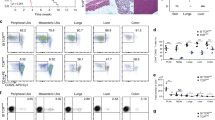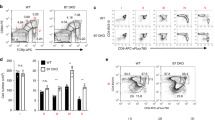Abstract
Despite increasing evidence for the existence of antigen-specific regulatory T cells, the mechanisms underlying suppression remain unclear. In this study we have identified and cloned a novel subset of antigen-specific regulatory T cells and demonstrated that these T cells possess a unique combination of cell surface markers and array of cytokines. The regulatory T cells are able to inhibit the function of T cells carrying the same T-cell receptor specificity and prevent skin allograft rejection in an antigen-specific, dose-dependent manner. The regulatory T cells are able to acquire alloantigen from antigen-presenting cells, present the alloantigen to activated syngeneic CD8+ T cells and then send death signals to CD8+ T cells. These findings provide a novel mechanism of regulatory T-cell-mediated, antigen-specific suppression.
This is a preview of subscription content, access via your institution
Access options
Subscribe to this journal
Receive 12 print issues and online access
$209.00 per year
only $17.42 per issue
Buy this article
- Purchase on Springer Link
- Instant access to full article PDF
Prices may be subject to local taxes which are calculated during checkout






Similar content being viewed by others
References
Qin,S. et al. “Infectious” transplantation tolerance. Science 259, 974–976 ( 1993).
Chen,Y., Kuchroo,V.K., Inobe, J., Hafler, D.A. & Weiner, H.L. Regulatory T cell clones induced by oral tolerance: Suppression of autoimmune encephalomyelitis. Science 265, 1237–1240 (1994).
Baxter, A.G., Kinder, S.J., Hammond, K.J.L., Scollay,R. & Godfrey,D.I. Association between αβTCR+CD4−CD8− T-cell deficiency and IDDM in NOD/Lt mice. Diabetes 46, 572 –582 (1997).
Groux, H. et al. A CD4+ T-cell subset inhibits antigen-specific T-cell responses and prevents colitis. Nature 389, 737–742 (1997).
Han, H.S., Jun, H.S., Utsugi, T. & Yoon, J.W. A new type of CD4+ suppressor T cells completely prevents spontaneous autoimmune diabetes and recurrent diabetes in syngeneic islet-transplanted NOD mice. J. Autoimmune 9, 331–339 (1996).
Olivares-Villagomez, D., Wang, Y. & Lafaille, J.J. Regulatory CD4+ T cells expressing endogenous T cell receptor chains protect myelin basic protein-specific transgenic mice from spontaneous autoimmune encephalomyelitis. J. Exp. Med. 188, 1883–1894 ( 1998).
Cobbold, S. & Waldmann, H. Infectious tolerance. Curr. Opin. Immunol. 10, 518–524 (1998).
Zhai, Y. & Kupiec-Weglinski, J.W. What is the role of regulatory T cells in transplantation tolerance? Curr. Opin. Immunol. 11, 497–503 (1999).
Waldmann, H. Transplantation tolerance —where do we stand? Nature Med. 5, 1245–1248 ( 1999).
Bushell, A., Niimi, M., Morris, P.J. & Wood, K.J. Evidence for immune regulation in the induction of transplantation tolerance: A conditional but limited role for IL-4. J. Immunol. 162, 1359–1366 (1999).
Chai, J.-G. et al. Anergic T cells act as suppressor cells in vitro and in vivo. Eur. J. Immunol. 29, 686– 692 (1999).
Seddon, B. & Mason, D. Peripheral autoantigen induces regulatory T cells that prevent autoimmunity. J. Exp. Med. 189 , 877–882 (1999).
Lancaster, F., Chui, Y.L. & Batchelor, J.R. Anti-idiotypic T cells suppress rejection of renal allografts in rats. Nature 315, 336– 337 (1985).
Ierino, F.L., Yamada, K., Hatch, T., Rembert, J. & Sachs, D. Peripheral tolerance to Class I mismatched renal allografts in miniature swine: Donor antigen-activated peripheral blood lymphocytes from tolerant swine inhibit antidonor CTL reactivity. J.Immunol. 162, 550–559 (1999).
Yang, L.M., DuTemple, B., Khan, Q. & Zhang, L. Mechanisms of long-term donor-specific allograft survival induced by pretransplant infusion of lymphocytes . Blood 91, 324–330 (1998).
Yang, L.M., DuTemple, B., Gorczynski, R.M., Levy, G.A. & Zhang,L. Evidence for epitope spreading and active suppression in skin graft tolerance after donor specific transfusion . Transplantation 67, 1404– 1410 (1999).
Zhang, L., Miller, R.G. & Zhang, J. Characterization of apoptosis-resistant antigen-specific T cells in vivo. J.Exp.Med. 183, 2065– 2073 (1996).
Sha,W.C. et al. Positive and negative selection of an antigen receptor on T cells in transgenic mice. Nature 336, 73– 76 (1988).
Zhang, X., Sun, S., Hwang, I., Tough, D.F. & Sprent, J. Potent and selective stimulation of memory-phenotype CD8+ T-cells in vivo by IL-15. Immunity 8, 591–599 (1998).
Tanchot, C. et al. Modifications of CD8+ T-cell function during in vivo memory or tolerance induction. Immunity 8, 581–590 (1998).
Sykes, M., Hoyles, K.A., Romick, M.L. & Sachs, D.H. In vitro and in vivo analysis of bone marrow-derived CD3+CD4−CD8−, NK1.1+ cell lines . Cell. Immunol. 129, 478– 493 (1990).
Strober, S., Palathumpat, V., Schwadron, R. & Hertel-Wulff, B. Cloned natural suppressor cells prevent lethal graft-vs-host disease. J. Immunol. 138, 699–703 (1987).
Abraham, V.S., Sachs, D.H. & Sykes, M. Mechanism of protection from graft-versus-host disease mortality by IL-2. J. Immunol. 148, 3746 –3752 (1998).
Strober, S. et al. Double negative (CD4−CD8− αβ+ T-cells which promote tolerance induction and regulate autoimmunity. Immunol.Rev. 149, 217–230 (1996).
Erard, F., Wild, M.-T., Garcia-Sanz, J.A. & Le Gross, G. Switch of CD8 T cells to noncytolytic CD8−CD4− cells that make Th2 cytokines and help B cells. Science 260, 1802–1805 ( 1993).
Wahl, S.M. Transforming growth factor beta: the good, the bad, the ugly. J. Exp. Med. 180, 1587–1590 (1994).
King, C. et al. TGF-β1 alters APC preference, polarizing islet antigen responses toward a Th2 phenotype. Immunity 8, 601– 613 (1998).
Lombardi, G., Sidhu, S., Batchelor, R. & Lechler, R. Anergic T cells as suppressor cells in vitro. Science 264, 1587–1589 (1994).
Kagi, D. et al. Fas and perforin pathways as major mechanisms of T cell-mediated cytotoxicity. Science 265, 528– 530 (1994).
Khan, Q., Penninger, J.M., Yang, L.M., Marra, L.E.K.I. & Zhang, L. Regulation of apoptosis in mature αβ+ CD4−CD8− antigen-specific suppressor T-cell clones. J. Immunol. 162, 5860–5867 (1999).
Thilenius, A.R., Sabelko-Downes, K.A. & Russell, J.H. The role of the antigen-presenting cell in Fas-mediated direct and bystander killing: potential in vivo function of Fas in experimental allergic encephalomyelitis. J. Immunol. 162, 643–650 (1999).
Kuwano, K. & Arai, S. Involvement of two distinct killing mechanisms in bystander target cell lysis induced by a cytotoxic T lymphocyte clone. Cell. Immunol. 169, 288– 293 (1996).
Smyth, M.J. & Sedgwick, J.D. Delayed kinetics of tumor necrosis factor-mediated bystander lysis by peptide-specific CD8+ cytotoxic T lymphocytes. Eur. J. Immunol. 28, 4162 –4169 (1998).
Huang, J.F. et al. TCR-Mediated internalization of peptide-MHC complexes acquired by T cells. Science 286, 952– 954 (1999).
Patel, D.M., Arnold, P.Y., White, G.A., Nardella, J.P. & Mannie, M.D. Class II MHC/peptide complexes are released from APC and are acquired by T cell responders during specific antigen recognition. J. Immunol. 163, 5201 –5210 (1999).
Sprent, J. Presidential address to the American Association of Immunologists. Stimulating naive T cells. J. Immunol. 163, 4629– 4636 (1999).
Cai, Z. & Sprent, J. Resting and activated t-cells show different requirements for CD8 molecules. J. Exp. Med. 179, 2005–2015 (1994).
Sambhara, S.R. & Miller, R.G. Programmed cell death of T cells signaled by the T cell receptor and the α3 domain of Class I MHC. Science 252, 1424– 1427 (1991).
Matzinger, P. The JAM test. A simple assay for DNA fragmentation and cell death. J. Immunol. Methods 145, 185–192 (1991).
Ohteki, T. et al. Identification of a cross-reactive self ligand in virus-mediated autoimmunity. Eur. J. Immunol. 29, 2886– 2896 (1999).
Acknowledgements
The authors thank P. Ohashi for providing LCMV-gp TCR transgenic mice and p33 peptides, H. Eilson for the 1B2 hybridoma, D.Y. Loh for providing a breeding stock of 2C transgenic mice and J. Chamberlain for providing HY Tg mice. The authors also thank J.M. Penninger, J. H. Russell, R.M. Gorczynski, R.G. Miller and M. Julius for critically reading the manuscript. This work is supported by Medical Research Council of Canada (MT 14431 to LZ) and Leukemia Research Fund of Canada (to L. Zhang).
Author information
Authors and Affiliations
Corresponding author
Rights and permissions
About this article
Cite this article
Zhang, ZX., Yang, L., Young, K. et al. Identification of a previously unknown antigen-specific regulatory T cell and its mechanism of suppression. Nat Med 6, 782–789 (2000). https://doi.org/10.1038/77513
Received:
Accepted:
Issue Date:
DOI: https://doi.org/10.1038/77513
This article is cited by
-
Peripheral immune cell profiling of double-hit lymphoma by mass cytometry
BMC Cancer (2023)
-
Human γδ T cells induce CD8+ T cell antitumor responses via antigen-presenting effect through HSP90-MyD88-mediated activation of JNK
Cancer Immunology, Immunotherapy (2023)
-
Application of double-negative T cells in haematological malignancies: recent progress and future directions
Biomarker Research (2022)
-
Immune evolution from preneoplasia to invasive lung adenocarcinomas and underlying molecular features
Nature Communications (2021)
-
Human double negative T cells target lung cancer via ligand-dependent mechanisms that can be enhanced by IL-15
Journal for ImmunoTherapy of Cancer (2019)



